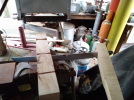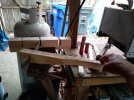As said, clamping immediately after quench in flat plates is common. See below for another method of dealing with warp.
A coat of HT anti-scale would be wise. Brownell's, Nu-Clayer, ATP, Turco.
A carbide straightening hammer may be nice to have around for warps you discover in the sanding stages.
Some good metallurgy to know:
1) When you heat the blade to the HT temp above non-magnetic the structure of the steel is austenite. Austenite is very soft and bendable. A long thin blade may bend in the forge, so rotate it from side to side as it comes up to the target temperature.
2) When you quench the blade, and it cools fast enough to miss the pearlite nose, it is still austenite. Technically, it is super-cooled austenite. It is still soft and can easily be bent.
3) Upon reaching the Ms point at 400°F it starts to become martensite. This is when it gets hard and very brittle. Any bending at this point will break the blade.
4) Tempering takes some of the brittleness out of the martensite and makes the blade usable. You lose a little hardness and gain a lot of toughness.
In 1095, after about 2-3 seconds in the quench oil the blade is below 1000°F, and you can pull out the blade and straighten any warps using a wooden mallet against a flat board (not the anvil) or with gloved hands. It is still rubbery soft austenite for about 5-8 more seconds. If you feel the blade start to stiffen as you straighten it, STOP straightening and wait until after tempering to straighten. All straightening should be done at the tempering temperature - for 1095 usually around 400°F. Repeated straightening attempts can be done after 30 minutes in the oven at 400°F. You can do as many straightening heats as needed with no loss of hardness. Trying to straighten a room temp 1095 blade will often give you two smaller blades.
Best Choice - Using a set of Japanese straightening tools makes taking the warp and twist out of blades fast, and you can usually fix most of the issue during the time between 1000°F and 400°F.
They are simple a set of wooden boards. One has slots to slide the blade in and the other is a leverage board with a slot.
Here is a past article I wrote on using Japanese straightening boards for swords. They work fine on any size blade as well.
TIP:
The easiest way to straighten warps and twists on long blades and swords is to make a Japanese straightening board and bending tool. These are ancient Japanese tools for straightening blades. I forget the proper names for them in Japanese (I think the hand tool is called the padoru, and I am going to call the fixed board with slots the tanima ita). They are used to straighten hot blades right out of the quench, or warm blades after tempering. You can also work a small warp/twist on a cold blade, but that is always a risk. The trick on getting warp/twist out of a hardened blade is to do it warm at 400°F and stop at 200°F. Reheat the blade as often as needed. You can spot heat a blade by gently heating with a torch over the whole area to around 400°F. This works great for tangs that need a little adjusting.
In talking temperatures for straightening blades, the terms are: HOT= 1000°-400°F; WARM = 400°-200°F; COLD = room temperature
The
board is a 2-3" thick piece of hardwood about 6"X12". Cut three slots down the side about 4" apart. Make the slots 1/4", 1/2", and 1" wide. The slots should go 3" deep into the board. These slots will be used as the fulcrum point for bending the blade in straightening. The wider slots should be filed or sanded to an hourglass curvature. The
hand tool is a wooden slat about 1" thick by 4" wide by 24" long. About 4" from one end make a 1/4" to 1/2"" wide slot in the side 2" deep. You can make a second hand tool with a 1/4" slot for taking out twists or working on thinner blades.
The hand tool is used to apply pressure to a spot along the blade in bending/twisting. Shape the rest of the wood past the slot sort of like a canoe paddle or tiller handle to make gripping it easier.
How to use these tools - Clamp the
board in the vise with the slots above the jaws or screw it permanently to a worktable/bench in the HT area. Immediately after the quench you can stick the hot blade in the straightening board slot (pick the slot size that seems best for the warp and blade size) and bend it straight. You have an 8-second window of time that the blade is still austenite and very soft to do this. Place the blade in the
board and use the
hand tool to straighten without affecting other areas. After the temper cycles, you can further straighten a warm blade. Repeat with extra temper cycles as needed until it is straight. 30 minutes is long enough for the blade to re-heat for another straightening try. For twists, place the blade in the smallest slot and use the smaller slot hand tool to counter-twist the blade as needed. Twist is easiest removed right after the quench. These wooden tools won't suck the heat out of the blade and promote a broken blade the way a cold metal vise will.
Below are some photos of the Slot board and Hand tool:
You can see how easily and evenly it bends the wakizashi in the photo. Force can be applied from a minute adjustment to a huge bend with one hand.
A blade right out of the quench is still austenite until it drops below 400°F. It can be straightened and untwisted with minimal effort with this fixture.
My fixture has a 2.5" thick board and a 2" thick (at the notch) leverage tool. My board is maple, and the tool is ash. You can use anything you have on hand. Even pine framing lumber will work. Once you make one of these and get used to it you will never use another straightening method.
To straighten a gentle warp., put the leverage tool farther away from the fixed board. To do an acute warp, place it close to the board. For a twist, place far/close as needed depending on the twist severity and location. You can isolate any bend/warp/twist between the tool and board with no other area being affected.




